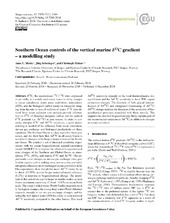| dc.contributor.author | Morée, Anne | |
| dc.contributor.author | Schwinger, Jörg | |
| dc.contributor.author | Heinze, Christoph | |
| dc.date.accessioned | 2019-06-28T07:53:59Z | |
| dc.date.available | 2019-06-28T07:53:59Z | |
| dc.date.issued | 2018-12-04 | |
| dc.Published | Morée A, Schwinger J, Heinze C. Southern Ocean controls of the vertical marine δ13C gradient – a modelling study. Biogeosciences. 2018;15(23):7205-7223 | eng |
| dc.identifier.issn | 1726-4170 | en_US |
| dc.identifier.issn | 1726-4189 | en_US |
| dc.identifier.uri | https://hdl.handle.net/1956/20500 | |
| dc.description.abstract | δ 13 C, the standardised 13C/12C ratio expressed in per mille, is a widely used ocean tracer to study changes in ocean circulation, water mass ventilation, atmospheric pCO2, and the biological carbon pump on timescales ranging from decades to tens of millions of years. δ13C data derived from ocean sediment core analysis provide information on δ 13 C of dissolved inorganic carbon and the vertical δ13C gradient (i.e. Dδ13C) in past oceans. In order to correctly interpret δ13C and Dδ13C variations, a good under standing is needed of the influence from ocean circulation, air–sea gas exchange and biological productivity on these variations. The Southern Ocean is a key region for these processes, and we show here that Dδ13C in all ocean basins is sensitive to changes in the biogeochemical state of the Southern Ocean. We conduct a set of idealised sensitivity experiments with the ocean biogeochemistry general circulation model HAMOCC2s to explore the effect of biogeochemical state changes of the Southern and Global Ocean on atmospheric δ13C, pCO2, and marine δ13C and Dδ13C. The experiments cover changes in air–sea gas exchange rates, particulate organic carbon sinking rates, sea ice cover, and nutrient uptake efficiency in an unchanged ocean circulation field. Our experiments show that global mean Dδ13C varies by up to about ±0.35 ‰ around the pre-industrial model reference (1.2 ‰) in response to biogeochemical change. The amplitude of this sensitivity can be larger at smaller scales, as seen from a maximum sensitivity of about −0.6 ‰ on ocean basin scale. The ocean’s oldest water (North Pacific) responds most to biological changes, the young deep water (North Atlantic) responds strongly to air–sea gas exchange changes, and the vertically well-mixed water (SO) has a low or even reversed Dδ13C sensitivity compared to the other basins. This local Dδ13C sensitivity depends on the local thermodynamic dis- equilibrium and the Dδ13C sensitivity to local POC export production changes. The direction of both glacial (intensi- fication of Dδ13C) and interglacial (weakening of Dδ13C) Dδ13C change matches the direction of the sensitivity of bio-geochemical processes associated with these periods. This supports the idea that biogeochemistry likely explains part of the reconstructed variations in Dδ13C, in addition to changes in ocean circulation. | en_US |
| dc.language.iso | eng | eng |
| dc.publisher | Copernicus Publications | en_US |
| dc.relation.uri | https://www.biogeosciences.net/15/7205/2018/ | |
| dc.rights | Attribution CC BY | eng |
| dc.rights.uri | http://creativecommons.org/licenses/by/4.0 | eng |
| dc.title | Southern Ocean controls of the vertical marine δ13C gradient – a modelling study | en_US |
| dc.type | Peer reviewed | |
| dc.type | Journal article | |
| dc.date.updated | 2019-01-28T08:16:25Z | |
| dc.description.version | publishedVersion | en_US |
| dc.rights.holder | Copyright 2018 The Author(s) | en_US |
| dc.identifier.doi | https://doi.org/10.5194/bg-15-7205-2018 | |
| dc.identifier.cristin | 1638891 | |
| dc.source.journal | Biogeosciences | |
| dc.relation.project | Universitetet i Bergen: 229771 | |
| dc.relation.project | Universitetet i Bergen: ns2980k | |
| dc.relation.project | Uni Research: 239965 | |

